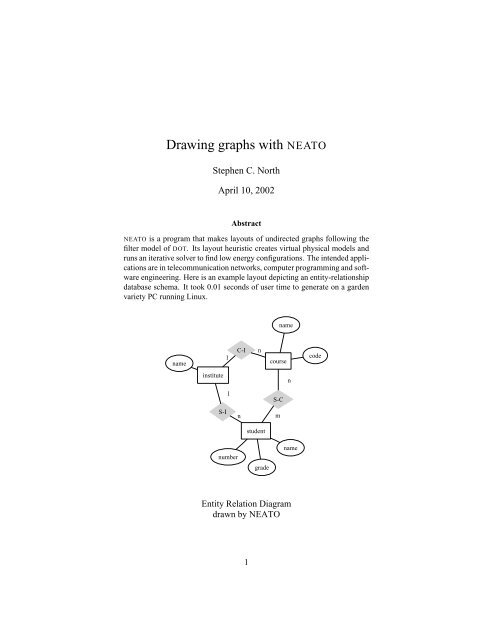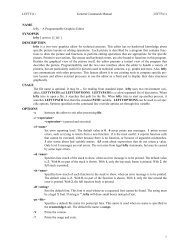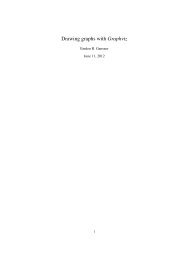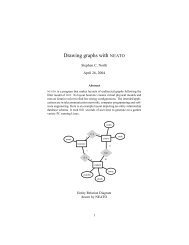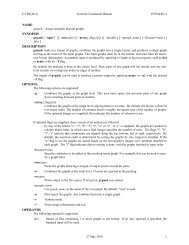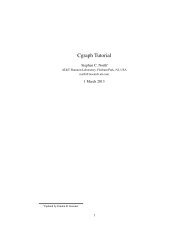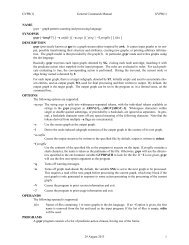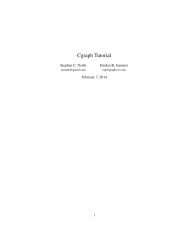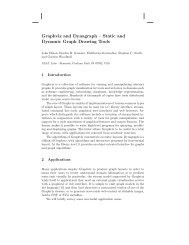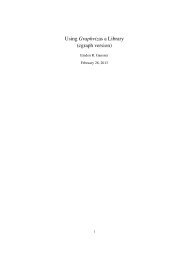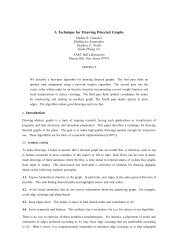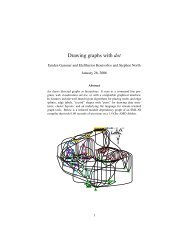Create successful ePaper yourself
Turn your PDF publications into a flip-book with our unique Google optimized e-Paper software.
<strong>Drawing</strong> <strong>graphs</strong> <strong>with</strong> <strong>NEATO</strong><br />
Stephen C. North<br />
April 10, 2002<br />
Abstract<br />
<strong>NEATO</strong> is a program that makes layouts of undirected <strong>graphs</strong> following the<br />
filter model of DOT. Its layout heuristic creates virtual physical models and<br />
runs an iterative solver to find low energy configurations. The intended applications<br />
are in telecommunication networks, computer programming and software<br />
engineering. Here is an example layout depicting an entity-relationship<br />
database schema. It took 0.01 seconds of user time to generate on a garden<br />
variety PC running Linux.<br />
name<br />
name<br />
1<br />
C-I<br />
n<br />
course<br />
code<br />
institute<br />
n<br />
1<br />
S-C<br />
S-I<br />
n<br />
m<br />
student<br />
number<br />
grade<br />
name<br />
Entity Relation Diagram<br />
drawn by <strong>NEATO</strong><br />
1
<strong>NEATO</strong> User’s Manual, April 10, 2002 2<br />
1 Introduction<br />
<strong>NEATO</strong> is a utility that draws undirected <strong>graphs</strong>, which are common in telecommunications<br />
and computer programming. It draws a graph by constructing a virtual<br />
physical model and running an iterative solver to find a low-energy configuration.<br />
Following an approach proposed by Kamada and Kawai [KK89], an ideal spring<br />
is placed between every pair of nodes such that its length is set to the shortest path<br />
distance between the endpoints. The springs push the nodes so their geometric distance<br />
in the layout approximates their path distance in the graph. This often yields<br />
reasonable layouts [Ead84][FR91]. (In statistics, this algorithm is also known as<br />
multidimensional scaling. Its application to graph drawing was noted by Kruskal<br />
and Seery in the late 1970s.)<br />
<strong>NEATO</strong> is compatible <strong>with</strong> the directed graph drawing program DOT in sharing<br />
the same input file format and graphics drivers [KN91]. Since the file format<br />
includes both undirected and directed <strong>graphs</strong>, <strong>NEATO</strong> draws <strong>graphs</strong> prepared for<br />
DOT, and vice versa. Both programs have the same options for setting labels, colors,<br />
shapes, text fonts, and pagination, and for generating code in common graphics<br />
languages (PostScript, raster formats such as GIF and PNG, SVG, FrameMaker<br />
MIF, HPGL/2, and web click maps). Both work <strong>with</strong> DOTTY, an interactive graph<br />
viewer for X windows. (The lneato command script runs neato from an interactive<br />
window.)<br />
Figs. 1–4 are representative examples of <strong>NEATO</strong>’s output. The timings refer to<br />
user time on a 600 Mhz Pentium Linux server. Fig. 1 was derived from a handmade<br />
drawing in an operating system tutorial. Fig. 2 shows the connectivity of a<br />
computer network. Fig. 3 shows the sharing of programmer-defined types between<br />
procedures in a C program. The program that was the source of this graph parses a<br />
text file into an internal data structure. The graph was extracted from a C program<br />
database. Its drawing shows where interactions or conversions between types may<br />
occur. Finally, Fig. 4 shows relationships between IMRs (modification requests)<br />
in an externally released software product. 1 The labeled nodes are IMRs and the<br />
small circles encode many-to-many dependencies.<br />
1 Graph courtesy of J. Hoshen, Bell Labs.
<strong>NEATO</strong> User’s Manual, April 10, 2002 3<br />
graph G {<br />
run -- intr;<br />
intr -- runbl;<br />
runbl -- run;<br />
run -- kernel;<br />
kernel -- zombie;<br />
kernel -- sleep;<br />
kernel -- runmem;<br />
sleep -- swap;<br />
swap -- runswap;<br />
runswap -- new;<br />
runswap -- runmem;<br />
new -- runmem;<br />
sleep -- runmem;<br />
}<br />
zombie<br />
runbl<br />
intr<br />
run<br />
kernel<br />
sleep<br />
runmem<br />
new runswap<br />
swap<br />
Figure 1: Process States in an Operating System Kernel (0.03 seconds)<br />
FL<br />
LZ<br />
DR<br />
AN<br />
FJ<br />
MV<br />
MT<br />
ER<br />
ALC<br />
WH1<br />
HO3<br />
HR<br />
MH<br />
HO1<br />
IH1<br />
IW<br />
IHP<br />
ERC<br />
CB<br />
HV<br />
IH2<br />
IH4<br />
IHC<br />
MLM<br />
Figure 2: R&D Internet Backbone (0.08 seconds)
<strong>NEATO</strong> User’s Manual, April 10, 2002 4<br />
check_buffer<br />
prefix<br />
main<br />
init_spec_table<br />
out_heading<br />
open_source<br />
out_data<br />
rel<br />
spec_data<br />
fill_spec_table<br />
out_rel<br />
info<br />
spec_heading<br />
check_fclose<br />
check_fopen<br />
match<br />
Figure 3: Type Sharing Between Procedures in a C Program (0.41 seconds)
<strong>NEATO</strong> User’s Manual, April 10, 2002 5<br />
354221<br />
375319<br />
360672<br />
356741<br />
355288<br />
358584 371187 357538 375499<br />
354785 377562 355080 358159<br />
354878 355800 360104<br />
357769<br />
354757<br />
360144<br />
354546<br />
354771 356116 360839<br />
378108 358155<br />
354766 357793<br />
357340<br />
377220<br />
358157<br />
373300<br />
375134<br />
358471<br />
353506<br />
370510<br />
370509<br />
375024 375027<br />
354290<br />
379864<br />
383039<br />
379422<br />
379126<br />
377801<br />
382528<br />
381775<br />
357430<br />
380475 379169 377980<br />
370706<br />
380526<br />
382574<br />
379341<br />
380448 380298 378362<br />
358900<br />
372568<br />
378666<br />
377908 377971<br />
379972<br />
378656<br />
377924<br />
358224<br />
375557<br />
384096<br />
379339<br />
376956<br />
380571 377719<br />
377763<br />
381835<br />
382103 374741<br />
375508<br />
379848<br />
371942<br />
374700<br />
374886<br />
381211 375039 375507 382161 383174<br />
381897<br />
381901<br />
375519<br />
382928380604<br />
382409<br />
377380<br />
379968<br />
358930 374300<br />
352010<br />
382827<br />
358866<br />
341411<br />
371943<br />
359471<br />
379212<br />
376529<br />
359100<br />
384909<br />
380285<br />
380963<br />
382566<br />
382572<br />
381710<br />
382436<br />
Figure 4: IMR Dependencies (6.75 seconds)
<strong>NEATO</strong> User’s Manual, April 10, 2002 6<br />
$ cat example.dot<br />
graph G {<br />
n0 -- n1 -- n2 -- n3 -- n0;<br />
}<br />
$ neato -Tps example.dot -o example.ps<br />
n0<br />
n1<br />
n2<br />
n3<br />
Figure 5: Example Graph <strong>Drawing</strong><br />
2 Graph <strong>Drawing</strong><br />
2.1 Basic Commands<br />
The remainder of this memo gives a synopsis of <strong>NEATO</strong> features. Many of these<br />
should be familiar to users of DOT. Fig. 5 shows a graph file, its drawing, and the<br />
command that was executed. A graph file has a short header and a body consisting<br />
of nodes, edges, and attribute assignments. By default, nodes are drawn as ellipses<br />
labeled <strong>with</strong> node names. Undirected edges are created by the -- operator. Edges<br />
are drawn as straight lines and tend to be all about the same length.<br />
2.2 <strong>Drawing</strong> Options<br />
Table 1 lists the graph, node and edge attributes that affect the layout. The options<br />
to set labels, shapes, fonts, and sizes are convenient for many kinds of layouts. The<br />
drawing in figure 6 illustrates some of these features. 2 Options to set the size of the<br />
drawing, pagination, and output graphics language are also the same as in DOT.<br />
3 Adjusting Layouts<br />
Although layouts made by <strong>NEATO</strong> are close to a local optimum as defined by the<br />
forces the springs exert on the nodes, fine tuning or generation of alternative layouts<br />
may improve readability. Because <strong>NEATO</strong> uses unconstrained optimization, it does<br />
not enforce minimum separation constraints between nodes or between edges and<br />
2 Graph courtesy of Hector Zamora, DEFINITY.
<strong>NEATO</strong> User’s Manual, April 10, 2002 7<br />
F<br />
l #3<br />
B<br />
l #2<br />
l #5<br />
l #1<br />
l #1<br />
E<br />
A1 l #6<br />
A<br />
l #8<br />
l #7<br />
A2<br />
A3<br />
l #3<br />
l #4<br />
l #2<br />
C<br />
l #1<br />
l #1<br />
graph G {<br />
node [shape=box,style=filled];<br />
{node [width=.3,height=.3,shape=octagon,style=filled,color=skyblue] A1 A2 A3}<br />
A -- A1 [label="l #6"];<br />
A -- A2 [label="l #7"];<br />
A -- A3 [label="l #8"];<br />
{edge [style=invis]; A1 -- A2 -- A3}<br />
D<br />
}<br />
edge [len=3]; /* applies to all following edges */<br />
A -- B [label="l #1"]; A -- C [label="l #2"]; A -- D [label="l #3"];<br />
A -- E [label="l #4"]; A -- F [label="l #5"]; B -- C [label="l #1"];<br />
B -- E [label="l #2"]; B -- F [label="l #3"]; C -- D [label="l #1"];<br />
D -- E [label="l #1"];<br />
Figure 6: Node and Edge Options
<strong>NEATO</strong> User’s Manual, April 10, 2002 8<br />
nonadjacent nodes, so in dense <strong>graphs</strong> nodes and edges can be too close or overlap.<br />
There are three ways of trying to correct these errors:<br />
1) change the initial configuration<br />
2) adjust the solver parameters<br />
3) edit the input edge lengths and weights.<br />
3.1 Initial Configuration<br />
If no options are given, <strong>NEATO</strong> always makes the same drawing of a given graph<br />
file, because its initial node placement and the solver are deterministic. Random<br />
initial placement can yield different layouts. It is sometimes reasonable to make<br />
at least several different trial layouts, and accept the best one. Random initial<br />
placement is requested by setting the value of the graph attribute start. If the<br />
value is a number, it is taken as a seed for the random number generator. The layout<br />
is different for each seed, but still deterministic. If the value is not a number, the<br />
process ID or current time is used. Each run potentially yields a different drawing.<br />
For example:<br />
$ neato -Tps -Gstart=rand file.dot > file.ps<br />
3.2 Termination Threshold<br />
The solver is a Newton-Raphson algorithm that moves a node <strong>with</strong> a maximal δe on<br />
every iteration. The solver terminates when δe falls below some ɛ. The default (.1)<br />
is low enough that the layout is usually close to a local minimum, but not so low<br />
that the solver runs for a long time <strong>with</strong>out making significant progress. Smaller<br />
values of ɛ allow the solver run longer and potentially give better layouts. Larger<br />
values can decrease <strong>NEATO</strong>’s running time but <strong>with</strong> a reduction in layout quality.<br />
This may be a desirable tradeoff for large <strong>graphs</strong>. ɛ is set in the graph’s epsilon<br />
variable. You can also directly limit the number of iterations. It is convenient to do<br />
this on the command line:<br />
$ neato -Tps -Gepsilon=.001 small.dot -o small.ps<br />
$ neato -Tps -Gepsilon=1.5 big.dot -o big.ps<br />
$ neato -Tps -Gmaxiter=1000 big.dot -o big.ps<br />
3.3 Edge Lengths and Weights<br />
Since the layout depends on the input edge lengths and their weights, these can<br />
sometimes be adjusted to good effect. The length of an edge is the preferred distance<br />
between the endpoint nodes. Its weight is the strength of the corresponding
<strong>NEATO</strong> User’s Manual, April 10, 2002 9<br />
n0<br />
n3<br />
graph G {<br />
n0 -- n1 [len=2, style=bold];<br />
n1 -- n2 -- n3 -- n0;<br />
}<br />
n1<br />
n2<br />
Figure 7: Example graph <strong>with</strong> an edge stretched<br />
graph G {<br />
n0 [ pos = "0,0!" ];<br />
n1 [ pos = "2,0" ];<br />
n2 [ pos = "2,2!" ];<br />
n0 -- n1 -- n2 -- n3 -- n0;<br />
}<br />
n0<br />
n3<br />
n2<br />
n1<br />
Figure 8: Example graph <strong>with</strong> nodes pinned<br />
spring, and affects the cost if it is stretched or compressed. Invisible edges can also<br />
be inserted to adjust node placement. In figure 6, the length of some edges was set<br />
to 3 to make them longer than the default. Also, the two invisible edges affect A1,<br />
A2, and A3.<br />
There is also a way to also give the initial or final coordinates of individual<br />
nodes. The initial position, formatted as two comma-separated numbers, is entered<br />
in a node’s pos attribute. If ! is given as a suffix, the node is also pinned down.<br />
4 Eliminating Overlaps<br />
To improve clarity, it is sometimes helpful to eliminate overlapping nodes or edges.<br />
One way to eliminate node overlaps is just to scale up the layout (in terms of the
<strong>NEATO</strong> User’s Manual, April 10, 2002 10<br />
Name Default Values<br />
Node Attributes<br />
shape ellipse ellipse, box, circle, doublecircle, diamond,<br />
plaintext, record, polygon<br />
height,width .5,.75 height and width in inches<br />
label node name any string<br />
fontsize 14 point size of label<br />
fontname Times-Roman font family name, e.g. Courier, Helvetica<br />
fontcolor black type face color<br />
style<br />
graphics options, e.g. bold, dotted, filled<br />
color black node shape color<br />
pos<br />
initial coordinates (append ! to pin node)<br />
Edge Attributes<br />
weight 1.0 strength of edge spring<br />
label<br />
label, if not empty<br />
fontsize 14 point size of label<br />
fontname Times-Roman font family name<br />
fontcolor black type face color<br />
style<br />
graphics options, e.g. bold, dotted, dashed<br />
color black edge stroke color<br />
len 1.0 preferred length of edge<br />
dir none forward, back, both, or none<br />
decorate<br />
if set, draws a line connecting labels <strong>with</strong> their edges<br />
id<br />
optional value to distinguish multiple edges<br />
Graph Attributes<br />
start<br />
seed for random number generator<br />
size<br />
drawing bounding box, in inches<br />
page unit of pagination, e.g. 8.5,11<br />
margin .5,.5 margin included in page<br />
label<br />
caption for graph drawing<br />
fontsize 14 point size of label<br />
fontname Times-Roman font family name<br />
fontcolor black type face color<br />
orientation portrait may be set to landscape<br />
center<br />
when set, centers drawing on page<br />
overlap true may be set to false or scale<br />
splines false true makes edge splines if nodes don’t overlap<br />
sep 0 edge spline separation factor from nodes - try .1<br />
Table 1: <strong>Drawing</strong> attributes
<strong>NEATO</strong> User’s Manual, April 10, 2002 11<br />
center points of the nodes) as much as needed. This is enabled by setting the graph<br />
attribute overlap=scale. This transformation preserves the overall geometric<br />
relationships in the layout, but in bad cases can require high scale factors. Another<br />
way to eliminate node overlaps employs an interative heuristic. On each iteration,<br />
a bounded Voronoi diagram of the node center points is computed, and each node<br />
is moved to the center of its Voronoi cell. This is repeated until all overlaps are<br />
eliminated. A side-effect (perhaps unwanted) is that the adjusted layout tends to<br />
fill the bounding rectangle of the Voronoi diagram. The heuristic is activated by<br />
setting overlap=false.<br />
Edge overlaps (<strong>with</strong> nodes) can be prevented by drawning them <strong>with</strong> spline<br />
curves (<strong>with</strong> splines=true). Note that the spline drawing heuristic is expensive<br />
and probably should not be attempted on <strong>graphs</strong> that have more than a few dozen<br />
nodes.<br />
Areas for future work include non-rectangular Voronoi boundaries, faster edge<br />
routing heuristics, and techniques to prevent unnecessary edge intersections.<br />
5 Acknowledgments<br />
<strong>NEATO</strong>’s layout heuristic follows the work of Kamada and Kawai [KK89]. The implementation<br />
was originally part of the SALEM 3D viewer for mathematical structures<br />
written <strong>with</strong> David Dobkin and Nathaniel Thurston. In converting <strong>NEATO</strong> to<br />
a more traditional tool, the graphics code generator was borrowed from DOT. This<br />
includes code contributed by John Ellson and Emden Gansner. Steve Eick was an<br />
early user and offered some good suggestions about ways to adjust layouts. Emden<br />
Gansner also contributed the heuristics for eliminating node overlaps, based on a<br />
paper by David Rappaport and Kelly Lyons.<br />
References<br />
[Ead84] Peter Eades. A Heuristic for Graph <strong>Drawing</strong>. In Congressus Numerantium, volume<br />
42, pages 149–160, 1984.<br />
[FR91]<br />
Thomas M. J. Fruchterman and Edward M. Reingold. Graph <strong>Drawing</strong> by Forcedirected<br />
Placement. Software– Practice and Experience, 21(11):1129–1164,<br />
November 1991.<br />
[KK89] T. Kamada and S. Kawai. An algorithm for drawing general undirected <strong>graphs</strong>.<br />
Information Processing Letters, 31(1):7–15, April 1989.<br />
[KN91] Eleftherios Koutsofios and Stephen North. <strong>Drawing</strong> <strong>graphs</strong> <strong>with</strong> dot. Technical<br />
Report 910904-59113-08TM, AT&T Bell Laboratories, Murray Hill, NJ,<br />
September 1991.


